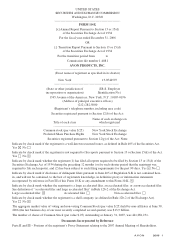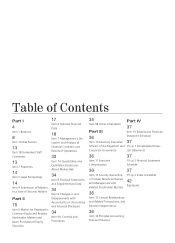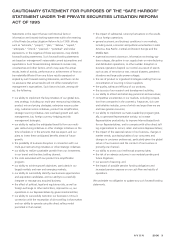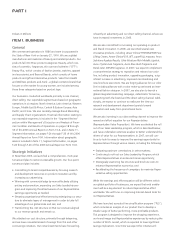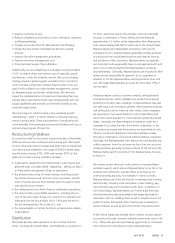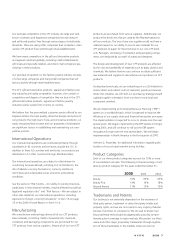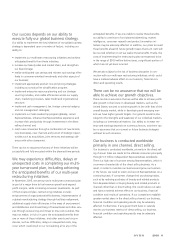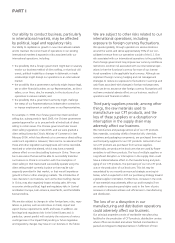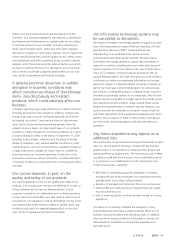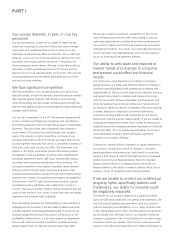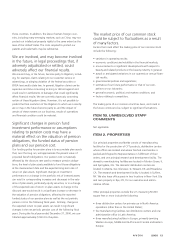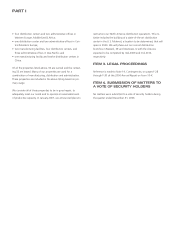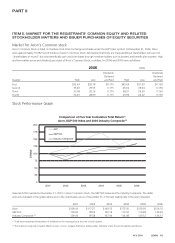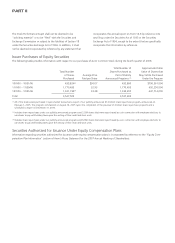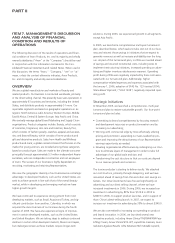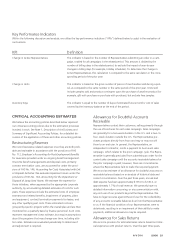Avon 2006 Annual Report Download - page 17
Download and view the complete annual report
Please find page 17 of the 2006 Avon annual report below. You can navigate through the pages in the report by either clicking on the pages listed below, or by using the keyword search tool below to find specific information within the annual report.orders, and one principal research and development facility.
Therefore, as a company engaged in manufacturing, distribution
and research and development on a global scale, we are subject
to the risks inherent in such activities, including industrial acci-
dents, environmental events, strikes and other labor disputes,
disruptions in logistics or information systems, loss or impairment
of key manufacturing sites, product quality control, safety, licens-
ing requirements and other regulatory issues, as well as natural
disasters, acts of terrorism and other external factors over which
we have no control. The loss of, or damage to, any of our facili-
ties or centers could have a material adverse effect on our busi-
ness, results of operations and financial condition.
A general economic downturn or sudden
disruption in business conditions may
affect consumer purchases of discretionary
items, including beauty and related
products, which could adversely affect our
business.
Consumer spending is generally affected by a number of factors,
including general economic conditions, inflation, interest rates,
energy costs, and consumer confidence generally, all of which
are beyond our control. Consumer purchases of discretionary
items tend to decline during recessionary periods, when dis-
posable income is lower, and may impact sales of our products.
In addition, sudden disruptions in business conditions as a result
of a terrorist attack similar to the events of September 11, 2001,
including further attacks, retaliation and the threat of further
attacks or retaliation, war, adverse weather conditions or other
natural disasters, such as Hurricane Katrina, pandemic situations
or large scale power outages can have a short or, sometimes,
long-term impact on consumer spending. A downturn in the
economies in which we sell our products or a sudden disruption
of business conditions in those economies could adversely affect
our sales.
Our success depends, in part, on the
quality and safety of our products.
Our success depends, in part, on the quality and safety of our
products. If our products are found to be defective or unsafe, or
if they otherwise fail to meet our Representatives’ or end
customers’ standards, our relationship with our Representatives
or end customers could suffer, we could need to recall some of
our products, our reputation could be diminished, and we could
lose market share and/or become subject to liability claims, any
of which could result in a material adverse effect on our busi-
ness, results of operations and financial condition.
Our information technology systems may
be susceptible to disruptions.
We employ information technology systems to support our busi-
ness, including systems to support financial reporting, an Enter-
prise Resource Planning (“ERP”) system which we are
implementing on a worldwide basis, and an internal
communication and data transfer network. We also employ
information technology systems to support Representatives in
many of our markets, including electronic order collection and
invoicing systems and on-line training. We have Internet sites in
many of our markets, including business-to-business sites to
support Representatives. We have recently announced initiatives
to increase our reliance on employing information technology
systems to support our Representatives, as well as initiatives, as
part of our multi-year restructuring program, to outsource cer-
tain services, including the provision of global human resources
information technology systems to our employees. Any of these
systems may be susceptible to outages due to fire, floods, power
loss, telecommunications failures, break-ins and similar events.
Despite the implementation of network security measures, our
systems may also be vulnerable to computer viruses, break-ins
and similar disruptions from unauthorized tampering with these
systems. The occurrence of these or other events could disrupt
our information technology systems and adversely affect our
operation.
Any future acquisitions may expose us to
additional risks.
We continuously review acquisition prospects that would comple-
ment our current product offerings, increase the size and geo-
graphic scope of our operations or otherwise offer growth and
operating efficiency opportunities. The financing for any of these
acquisitions could dilute the interests of our stockholders, result
in an increase in our indebtedness or both. Acquisitions may
entail numerous risks, including:
• difficulties in assimilating acquired operations or products,
including the loss of key employees from acquired businesses
and disruption to our direct selling channel;
• diversion of management’s attention from our core business;
• adverse effects on existing business relationships with suppli-
ers and customers; and
• risks of entering markets in which we have limited or no prior
experience.
Our failure to successfully complete the integration of any
acquired business could have a material adverse effect on our
business, financial condition and operating results. In addition,
there can be no assurance that we will be able to identify suit-
able acquisition candidates or consummate acquisitions on
favorable terms.
A V O N 2006 11


